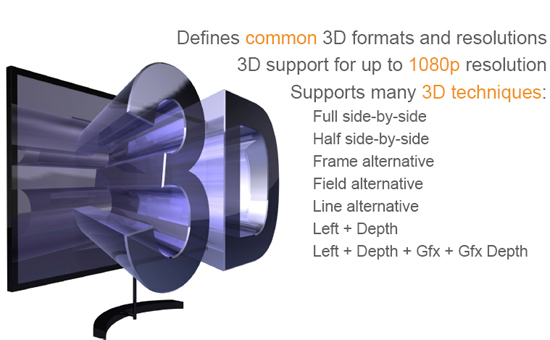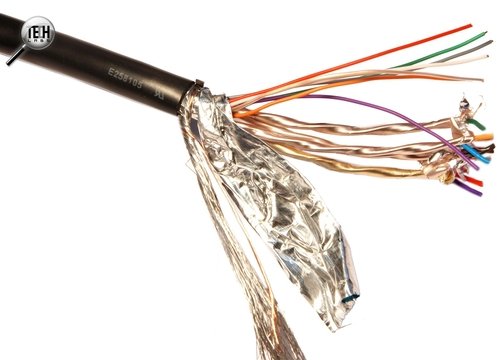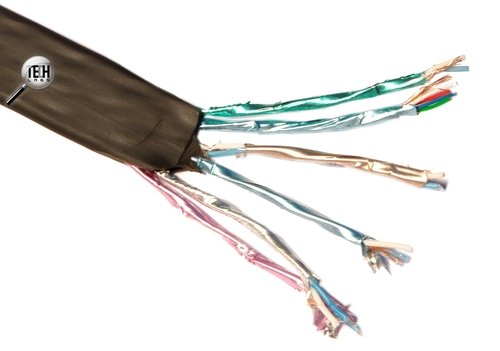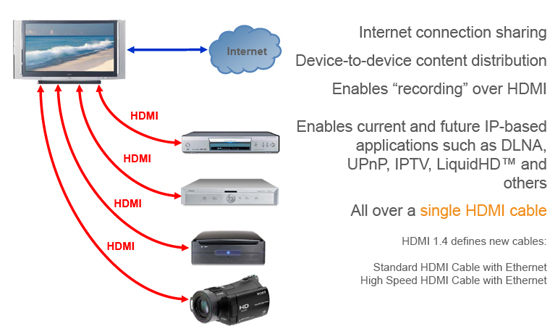HDMI interface, undoubtedly, is the most asked-for and prospective interface to realize all commutations as part of a typical AV system. Nowadays the market is still filled with devices with different component and composite outputs or inputs, but the majority of them can be attributed to anachronisms of the last epoch, the use of which is justified only in really nonstandard situations.
It is much easier to connect all components with a convenient digital cable, transmitting at that the image and sound. And the level of quality with HDMI connection is actually achieves the maximum. This standard grew from the current DVI cable, but digital streams, as everyone is well aware, enable to achieve much more impressive results as compared with the analog data transmission methods. It is possible to process gigabits of information per second via any worthy cable transmitting the most capacious HD content. The more so because HDMI standard evolves constantly and becomes more amicable for a user beginning from especially purely specifications to the appearance of more advanced connectors.
Delusions and the reality about 3D and network

However, with all, it would seem, the clarity of the question, most people up to the present have the whole set of delusions related just to the most asked-for trends of the market. To a large extent it was contributed by a new revision of HDMI version 1.4, because some of us do not simply understand by what it differs from version 1.3 essentially, and what in general is the difference between a good and bad cable. As a preliminary, we will note that HDMI 1.4 comes laden with some fundamentally new moments, but on the basis of factors related directly to the content, nothing of any substance has happened.
The most commonly occurring delusion is the linkage of 1.4 standard with 3D trend fashionable today. Of course, we hear about 3D on every corner and devices with realization of this technology become more affordable, but realities are such that it is possible to transmit such streams via any cable. And it couldn't care less, what version it will be – 1.3 or 1.4. The correctness of its construction with the observance of minimum engineering requirements is important only. Simply stated, any cable of a moderate length with the honest price $ 15...20 will be in service impeccably with any modern content including 3D.
The minimum set of requirements (the use of copper cores with normal cross-section, separate shielding of twisted pairs, general shielding by doubling methods, etc.) enables for the absolutely affordable product of version 1.3 to work just as distinguished cables at a price of thousands of dollars work. There are no limitations at all during transmission of any streams, as well as there are no interferences, but a delusive difference in details of the picture is noticeable only with the coincidence of enormous number of factors, starting from the trained eye and finishing with parameters of a TV-set. In general, in order to watch 3D neither too expensive cables, nor the compliance with some newest standards, nor some dances with the tambourine are not required at all. Any simple cable in good condition of a more or less fresh version is quite enough.


Coming back to HDMI 1.4, we note that the appearance of a separate network channel can be considered the main improvement. Such products have “HDMI with Ethernet” marking, but technically this opportunity is achieved by the appearance of another additional twisted pair. Network possibilities are developed so quickly that the period of stormy using traditional carriers of information in the form of habitual compact disks can be considered practically finished, and the handling to the digital content reproduction is changed in a big way.
In any case, nowadays nobody will be surprised by the Internet in a TV-set, but if we are speaking of reels of not high quality or torrents then those days when HD will be on-line are around the corner. And it has been also thought in a new specification of HDMI 1.4. An additional channel enables all devices to be connected to each another in the system with speed up to 100 Mbit/s. Roughly speaking, if a media player, for example, is connected to a global or local network, then there will be a possibility to use all network functions on a TV-set connected to it. An only nuance in this idyll is the fact that all components in such system must support HDMI 1.4 and these network functions. Unfortunately, suitable devices come to the market very sluggishly, and if there is a certain progress among TV-sets then with other devices everything is very bad.

Conclusion
On the whole, when selecting a cable for a certain system it is necessary to understand clear some moments abstracting from general delusions. For example, the compliance with 1.4 specifications is not required in order to reproduce 3D content. A cable can comply with 1.3 standard, there will be no problems during work, the main thing it would be of high-quality. The test of inexpensive cables has confirmed this statement in full. And the High Speed inscription can be the guarantee of this, which according to new rules means the compliance with the maximum quality level.
The main difference of HDMI 1.4 is the appearance of a network channel – HDMI with Ethernet marking. That makes it possible to distribute the network between devices in one AV system jointly with the image and sound. For the time being, this titbit is oriented more to “allow for growth”. However, if you pay your attention to unimportant difference in the cost of cables of different specifications, then you can safely buy new HDMI 1.4 cables, because the overpayment for perspective functions turns out to be scanty. In any case, it is not necessary to pay hundreds of dollars to use all innovations, the more so because any sufficiently worthy cables cope with them perfectly well.
